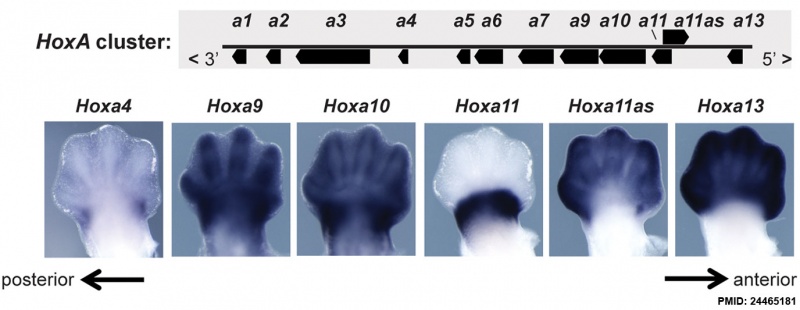File:Hoxa gene expression in limb bud 01.jpg

Original file (1,376 × 533 pixels, file size: 85 KB, MIME type: image/jpeg)
Hoxa gene expression in limb buds
Expression of Hoxa4, Hoxa9, Hoxa10, Hoxa11, Hoxa11 antisense (Hoxa11as), and Hoxa13 in E12.5 limb buds. The Hoxa11as transcript originates from a promoter within the intron of Hoxa11 (upper panel) and is expressed like Hoxa13.
PLoS Biol. 2014 Jan;12(1):e1001773. doi: 10.1371/journal.pbio.1001773. Epub 2014 Jan 21.
Conservation and divergence of regulatory strategies at Hox Loci and the origin of tetrapod digits.
Woltering JM1, Noordermeer D2, Leleu M2, Duboule D3.
Author information
Abstract
The evolution of tetrapod limbs from fish fins enabled the conquest of land by vertebrates and thus represents a key step in evolution. Despite the use of comparative gene expression analyses, critical aspects of this transformation remain controversial, in particular the origin of digits. Hoxa and Hoxd genes are essential for the specification of the different limb segments and their functional abrogation leads to large truncations of the appendages. Here we show that the selective transcription of mouse Hoxa genes in proximal and distal limbs is related to a bimodal higher order chromatin structure, similar to that reported for Hoxd genes, thus revealing a generic regulatory strategy implemented by both gene clusters during limb development. We found the same bimodal chromatin architecture in fish embryos, indicating that the regulatory mechanism used to pattern tetrapod limbs may predate the divergence between fish and tetrapods. However, when assessed in mice, both fish regulatory landscapes triggered transcription in proximal rather than distal limb territories, supporting an evolutionary scenario whereby digits arose as tetrapod novelties through genetic retrofitting of preexisting regulatory landscapes. We discuss the possibility to consider regulatory circuitries, rather than expression patterns, as essential parameters to define evolutionary synapomorphies.
Comment in
A footnote to the evolution of digits. [PLoS Biol. 2014]
PMID 24465181
http://journals.plos.org/plosbiology/article?id=10.1371/journal.pbio.1001773
Copyright: © 2014 Woltering et al. This is an open-access article distributed under the terms of the Creative Commons Attribution License, which permits unrestricted use, distribution, and reproduction in any medium, provided the original author and source are credited.
Figure 2. Journal.pbio.1001773.g002.jpg
File history
Click on a date/time to view the file as it appeared at that time.
| Date/Time | Thumbnail | Dimensions | User | Comment | |
|---|---|---|---|---|---|
| current | 15:29, 28 January 2015 | 1,376 × 533 (85 KB) | Z8600021 (talk | contribs) | ==Hoxa gene expression in limb buds== Expression of Hoxa4, Hoxa9, Hoxa10, Hoxa11, Hoxa11 antisense (Hoxa11as), and Hoxa13 in E12.5 limb buds. The Hoxa11as transcript originates from a promoter within the intron of Hoxa11 (upper panel) and is expressed... |
You cannot overwrite this file.
File usage
The following 2 pages use this file: